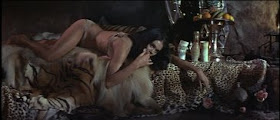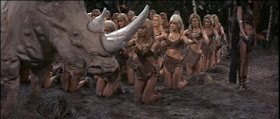 Even in 1965 Two on a Guillotine must have looked very old-fashioned, but it’s not entirely without its charms.
Even in 1965 Two on a Guillotine must have looked very old-fashioned, but it’s not entirely without its charms.It’s a combination of an Old Dark House horror mystery (a sub-genre that had already become hackneyed by the early 30s) and a romantic comedy. It does however involve stage magic, and I tend to be pretty tolerant of movies dealing with the world of illusionists.
'Duke' Duquesne is a celebrated stage magician. He is assisted in his act by his beautiful young wife, Melinda (Connie Stevens). They have an infant daughter, and his career is going well. They are working on a new trick, a rather macabre one involving a guillotine. And then Melinda disappears without explanation, and Duquesne retires from the stage and lives as a recluse for the remainder of his life. His daughter is sent to live with her aunt.
Twenty years later the daughter, Cassie (also played by Connie Stevens), receives word of her father’s death. She has had no contact with him sinc
 e her mother vanished. Duquesne’s funeral is a little on the bizarre side - according to his last wishes his coffin is chained and padlocked to make escape as difficult as possible. Duquesne has vowed to return from the dead if he can, and he wants it to be a challenge! His will is odd as well - his daughter gets everything so long as she lives in his house for a week, in case he really does return from the grave.
e her mother vanished. Duquesne’s funeral is a little on the bizarre side - according to his last wishes his coffin is chained and padlocked to make escape as difficult as possible. Duquesne has vowed to return from the dead if he can, and he wants it to be a challenge! His will is odd as well - his daughter gets everything so long as she lives in his house for a week, in case he really does return from the grave.She won’t be alone in the house though - a newspaper reporter (Dean Jones) has managed to convince her that he’s not really a newspaper reporter, he’s really a nice regular guy, and
 he’s talked his way into staying so that she ill have someone to protect her.
he’s talked his way into staying so that she ill have someone to protect her.These are the usual Old Dark House spooky clichés, there’s a blossoming romance, and finally after an inordinately long wait the actual plot kicks in. We find out what really happened to persuade the great magician to retire, and what really happened to his wife.
It’s not a bad little horror tale, but it could have been told very effectively in just over an hour. In fact the movie runs for 107 minutes. And that’s the problem. Dean Jones is harmless, Connie Stevens is c
 ute and amusing, Cesar Romero does some scenery-chewing. There are a couple of quite well done horror moments. There’s some gentle humour and some romance, and they’re handled competently enough. And there’s go-go dancing, always a major plus in my book.
ute and amusing, Cesar Romero does some scenery-chewing. There are a couple of quite well done horror moments. There’s some gentle humour and some romance, and they’re handled competently enough. And there’s go-go dancing, always a major plus in my book.All in all it’s innocuous and moderately entertaining if you’re in a tolerant mood.
I caught it on TCM at Halloween. I have no idea if it’s available on DVD. It’s definitely one to rent or watch on cable, rather than one to buy.

























